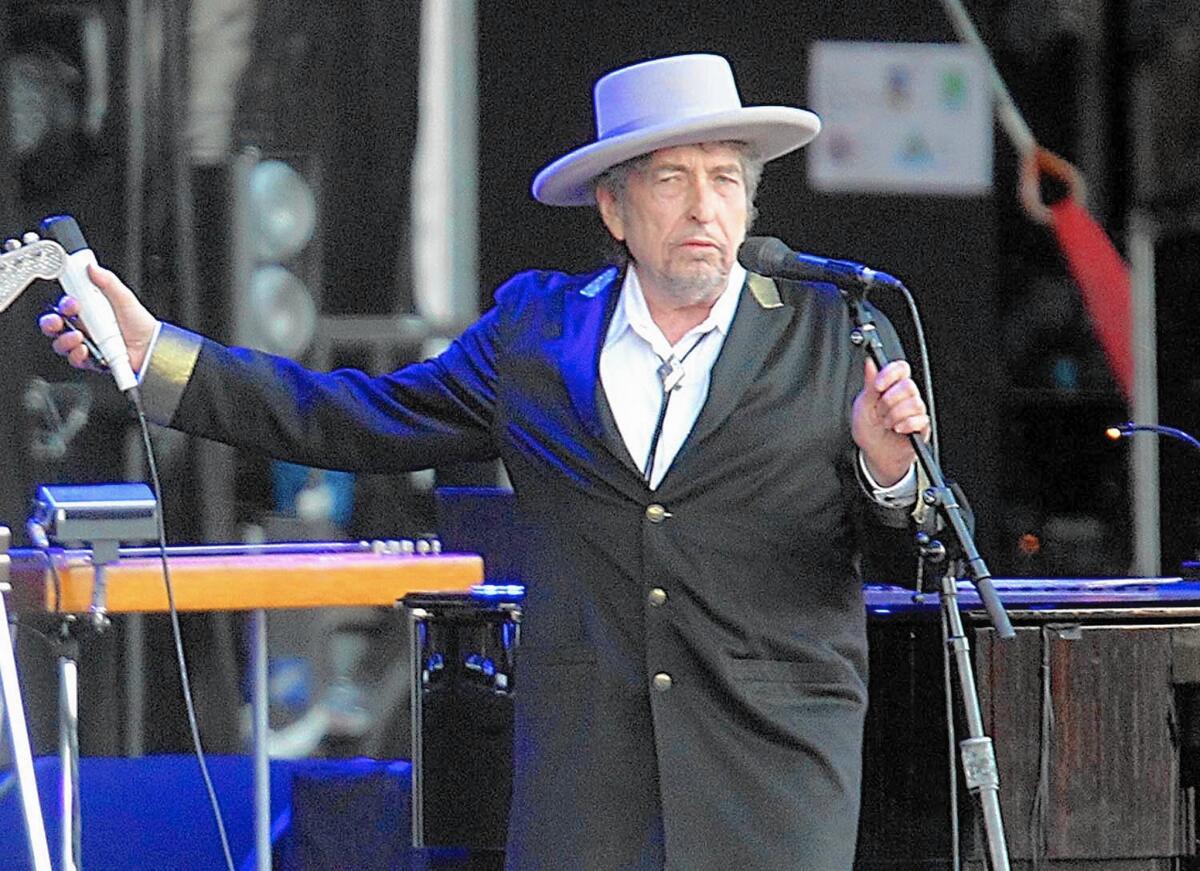Review: Bob Dylan’s ‘Shadows in the Night’ album illuminates American standards

- Share via
Call them standards if you must — imagine dusty old classics of the so-called Great American Songbook. But as interpreted by Bob Dylan, more accurate is to consider the entirety of “Shadows in the Night” as a gathering of meditations, or a booklet of hymns, or a selection of reveries.
Ten songs, 34 minutes, a soaring lifetime’s worth of emotion conveyed with the fearlessness of a cliff diver spinning flips and risking belly flops in the open air — that’s Dylan and his band on the graceful, often breathtaking “Shadows.” The record comes out Feb. 3.
Strikingly unadorned and as emotionally raw as anything in the artist’s canon, Dylan’s new studio album is rich with moaning pedal steel lines and tonal whispers that drift in and out of measures. Guided by bassist Tony Garnier’s liquid lines, “Shadows” is an exercise in precision, each syllable essential, each measure evenly weighted. Absent are piano, overdubs, all but the most minimal percussion or any lyric written by Dylan himself. And it’s as slow as molasses.
Rather, for “Shadows,” the 73-year-old artist gathered his longtime band into Studio B at Capitol Studios in Hollywood to celebrate the artfully penned lyric and melody. Resurrecting works, many obscure, written or cowritten in the decades between the 1920s and ‘60s by composers including Rodgers & Hammerstein, Irving Berlin, Matt Dennis & Tom Adair, Frank Sinatra and Buddy Kaye, the album is a celebration of the craft and enduring power of a seamless ballad.
-------------
For the Record
Jan. 26, 12:33 p.m.: An earlier version of this article said that Bob Dylan and his band recorded “Shadows in the Night” in Capitol Studios’ Studio A, which holds up to 50 musicians. They recorded the album in the smaller Studio B.
------------
A random selection of lines tells the story: Where is my happy ending? Where are you? Since you went away the days grow long. Full moon and empty arms. I’m a fool to love you. Take me back, I need you. What’ll I do when you are far away and I am blue? I’m sentimental, so I walk in the rain. I’ve got some habits even I can’t explain.
Songs of lovers gone, of vanishing emotions, of fading years and stubborn habits, of isolation, unanswered prayers and never-ending hope — you can feel the emptiness. The session was tight: Dylan circled by the five who tour with him: Garnier, Stu Kimball (rhythm guitar), Donnie Herron (pedal steel, lap steel), Charlie Sexton (lead guitar) and George Receli (drums, percussion). The occasional muted brass section washes through.
Recording the songs in the order in which they appear on the album, the artist didn’t even use headphones to monitor the mix. Rather, he listened to the experts around him, spiriting intimate takes on songs about autumn leaves, enchanted evenings and an ambivalent sun spinning around. So intimate is the recording that vague hints of Dylan’s breath can be heard at key moments. The occasional shuffle of a lyric sheet. A little inhale at the end of a lap steel line during “What’ll I Do.”
The result is akin to Willie Nelson’s “Stardust,” Chet Baker’s late-period “Let’s Get Lost” recordings or Jimmy Scott’s miraculous post-retirement comeback, “All the Way.” If there’s a connector, it’s that all the songs on “Shadows” were interpreted at one time or another by Frank Sinatra. But this certainly isn’t a tribute per se to that swinging stylist.
That’s a relief, as Dylan is obviously no Sinatra. His voice raw, pitchy and quivering, Dylan croons his way through elegantly crafted songs with seeming disinterest in flawless takes or perfect pitch. Yet it’s profound, thematically devastating and so well curated as to feel essential.
“Shadows in the Night” is an album that’s best appreciated when heard with intention, while sitting still, with volume and focus. It’s Dylan upending expectations once again, another left turn in a career filled with them, sharing his wisdom and defining himself through the lines of others. He’s done that both as a historian and a thief of American music, playing with context and blurring intentions in innumerable songs.
In that sense, the album’s closest companions in his repertoire are two equally intimate albums of cover songs from the early ‘90s that helped further define him, “Good as I Been to You” and “World Gone Wrong.” Those too were minimalist Dylan — just him and guitar. They featured the artist’s takes on a different brand of American song: haggard old blues songs and murder ballads. Both explored love and death through songs of violent betrayal. Then in his early 50s, Dylan still burned with feral passion, singing of “blood in my eyes” for a lover, of a life cut too short in “Delia.” For “Shadows,” that passion is supplanted with equanimity and hard-earned wisdom.
In fact, if there’s an underlying philosophy to “Shadows,” Dylan hints at it in his only interview in regards to the record. Strategically given to AARP magazine, he offered thoughts on aging and creative expression: “Passion is a young man’s game,” he said. “Young people can be passionate. Older people gotta be more wise. I mean, you’re around awhile, you leave certain things to the young. Don’t try to act like you’re young. You could really hurt yourself.”
The biggest entertainment stories
Get our big stories about Hollywood, film, television, music, arts, culture and more right in your inbox as soon as they publish.
You may occasionally receive promotional content from the Los Angeles Times.








